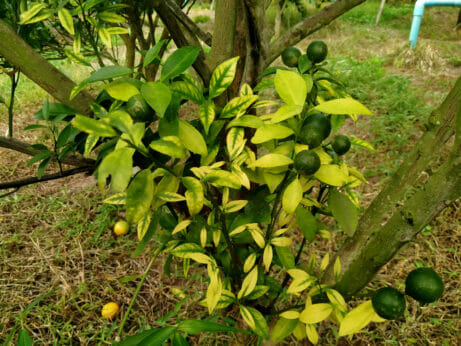Scientists have developed the first silk microneedle to deliver drugs to plants.

What if we had vaccines for field crops? Imagine a world where on-farm robots can deliver tiny injections into each plant, rendering crops resistant to the latest disease or rampant pest. It might also be possible to give growing fruits, vegetables, herbs and spices a jab as a quick way to send nutrients right to the source.
This is how a group of biomaterial scientists and engineers are envisioning the future of crops after developing the first microneedle-based drug delivery technique for plants. Their paper, published in the journal Advanced Materials, details how they were able to provide small compounds to a wide variety of plants and monitor plant response via biomaterial injection.
For roughly a year and a half, researchers based in Singapore and Cambridge, Massachusetts tested the needles using GA3, a plant growth regulator widely used in agriculture. Via genetic analysis, the group was able to closely examine the reaction of tomatoes, lettuce, spinach, rice, corn, barley and soybeans and confirm the effectiveness of the method, noting that it resulted in minimal scar and callus formation.
Benedetto Marelli, a corresponding author of the paper and associate professor at the Massachusetts Institute of Technology, says that the research on microneedle technology was motivated by the desire to offer farmers an alternative to spraying that is more sustainable and ecologically friendly.
“There is increasing pressure for the agriculture sector to adapt and stay resilient to the realities of climate change,” says Marelli. “When we consider the current option of spraying, it is scalable, but it can be harmful to the farmer and the environment by sending particles into the air or percolating in the soil, going into the aquifer and then draining into the water stream.”
According to Marelli, when sprays are used, roughly 50 to 90 per cent of an application ends up in the air or soil or doesn’t get fully absorbed into the plant tissue. The reason why the technology holds so much promise, he says, is because it offers a precise and streamlined way to deliver a substance by directly targeting the plant tissue. And because the needles are made of silk, they are biodegradable.
“You minimize the waste,” says Marelli.
While the invention is essentially a plant vaccine, these needles aren’t like the syringes used at the doctors office. To make them, Marelli and his team mixed functional compounds (in this case, GA3) into a silk fibroin solution. The mixture was then cast into a mold to dry and form the needles. Researchers used tweezers to grab the needles and pierce them into the plant tissue to release the compound directly inside the plant.
Yunteng Cao, the first author of the paper and postdoc researcher at MIT, says there are many ways in which the technology could make a positive impact, but Cao sees the microneedle as an especially promising solution to citrus greening disease, which has decimated the orange industry, particularly in Florida. A 2020 study estimated the damage of the disease amounted to more than $1 billion in annual revenue losses and 5,000 jobs lost each year in the sunshine state.

An example of citrus greening disease on an orange tree. (Photo: Shutterstock)
There is currently no cure for the disease, and spraying trees with an antibiotic has been shown to be largely ineffective because so little of the drug is absorbed into the plant’s system.
“I see this as a tool to help ensure the world has greater food security and ensure we can continue to grow food into the future,” says Cao. “I think we can have hope and excitement for what sorts of meaningful impacts our work can have.”
Researchers say the microneedles could also be used to design new crop traits, in addition to administering drugs or other inputs.
Their process to advance the project will involve trials on different plants and at various stages in their life cycle. They will also attempt to attract business partners that might be interested in manufacturing the technology and bringing it into the commercial space.
With those steps in mind, the researchers say they would be happy if the technology was available to farmers within the next seven years.